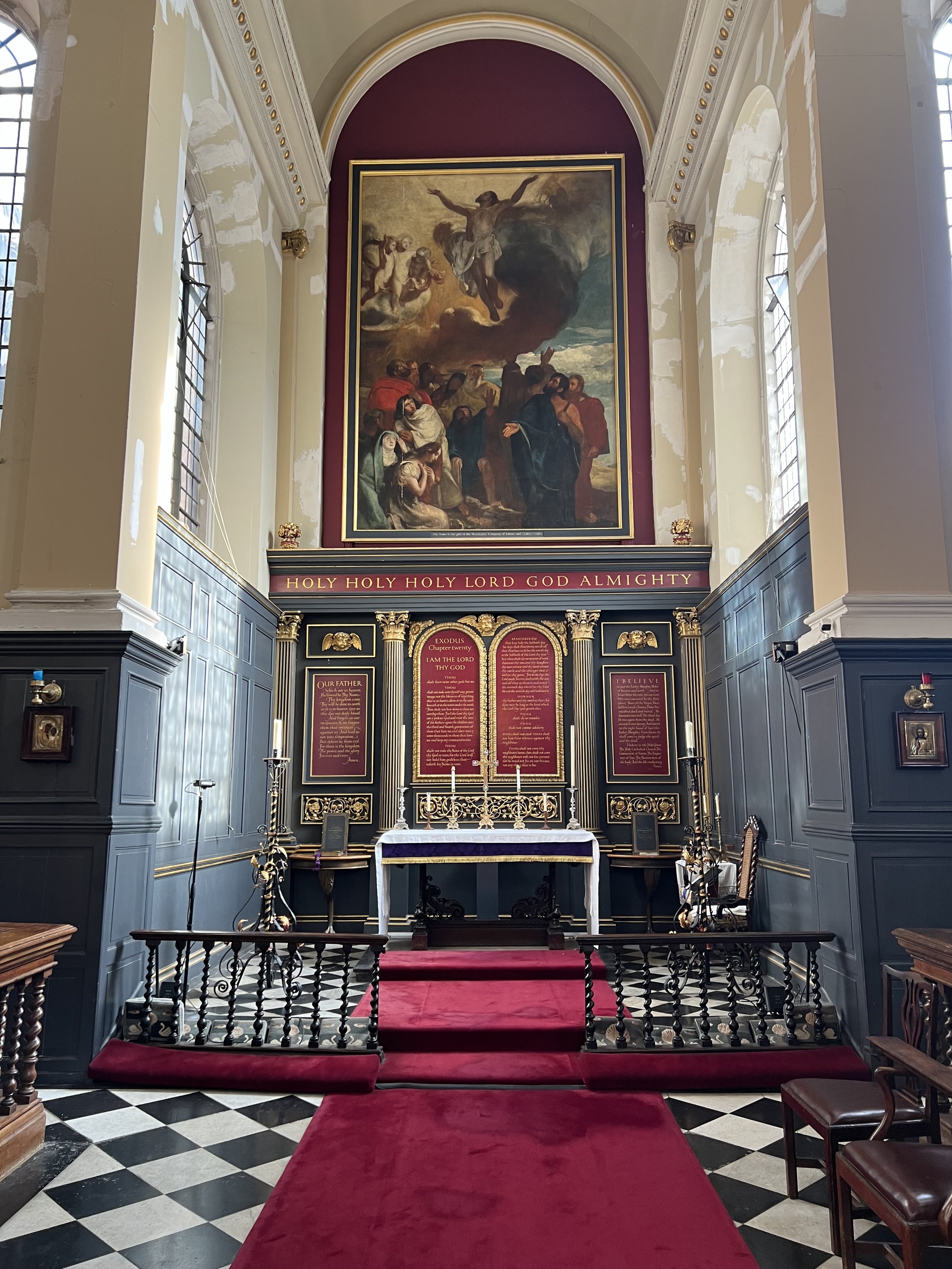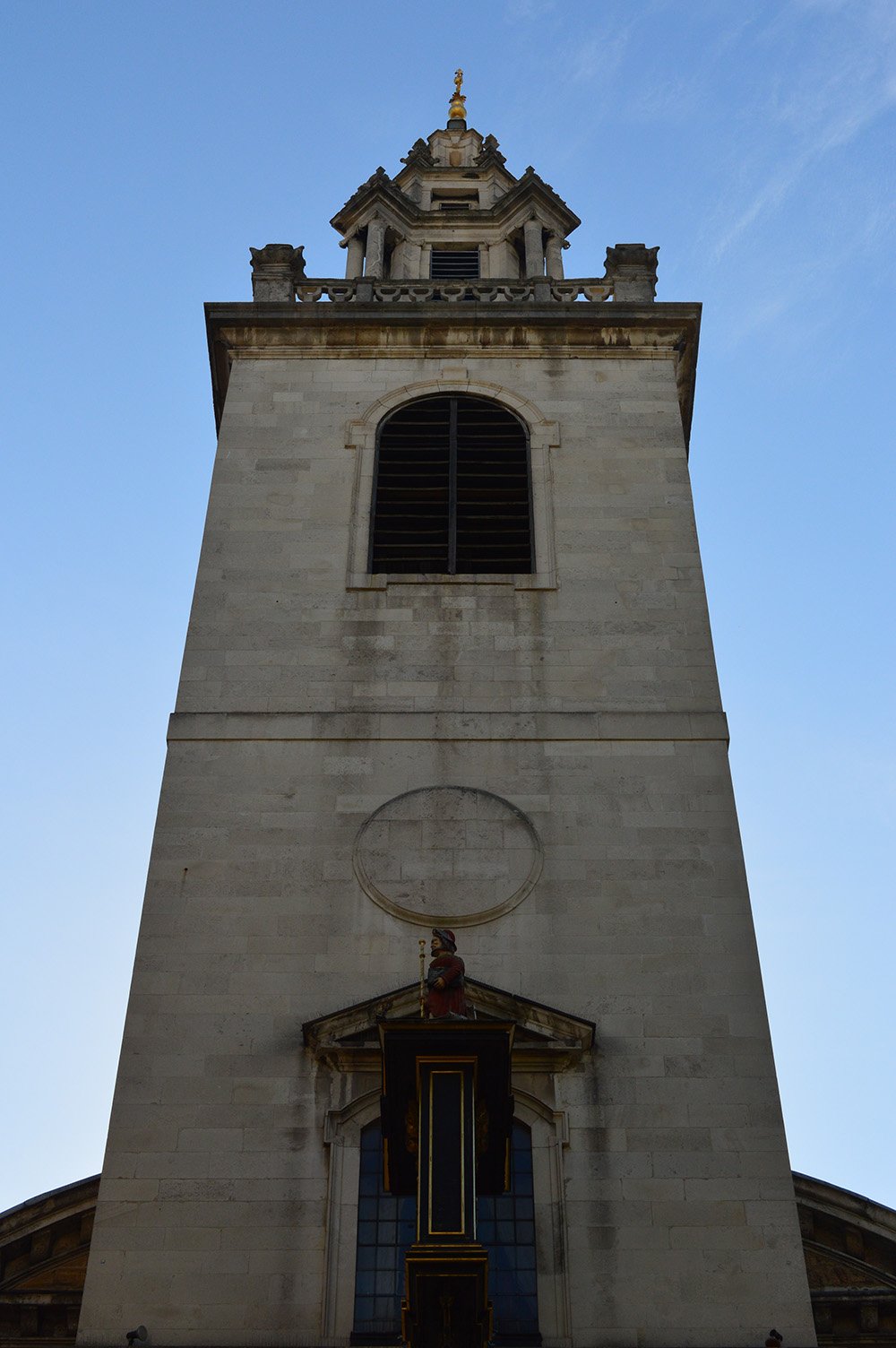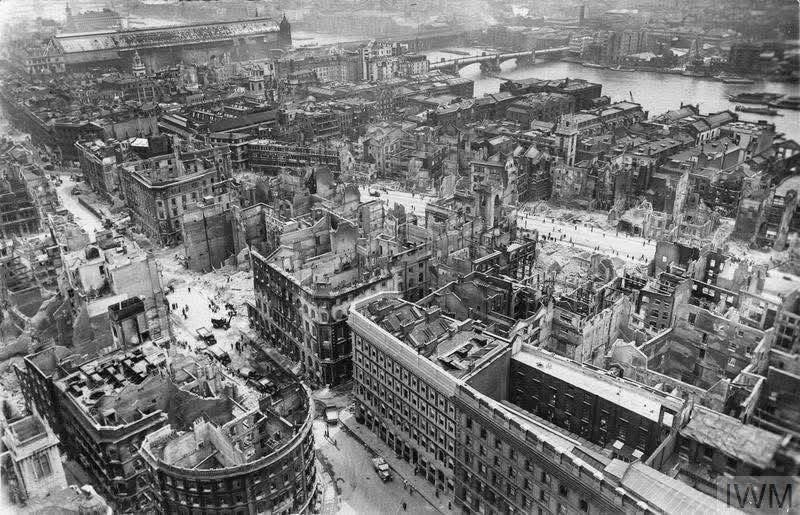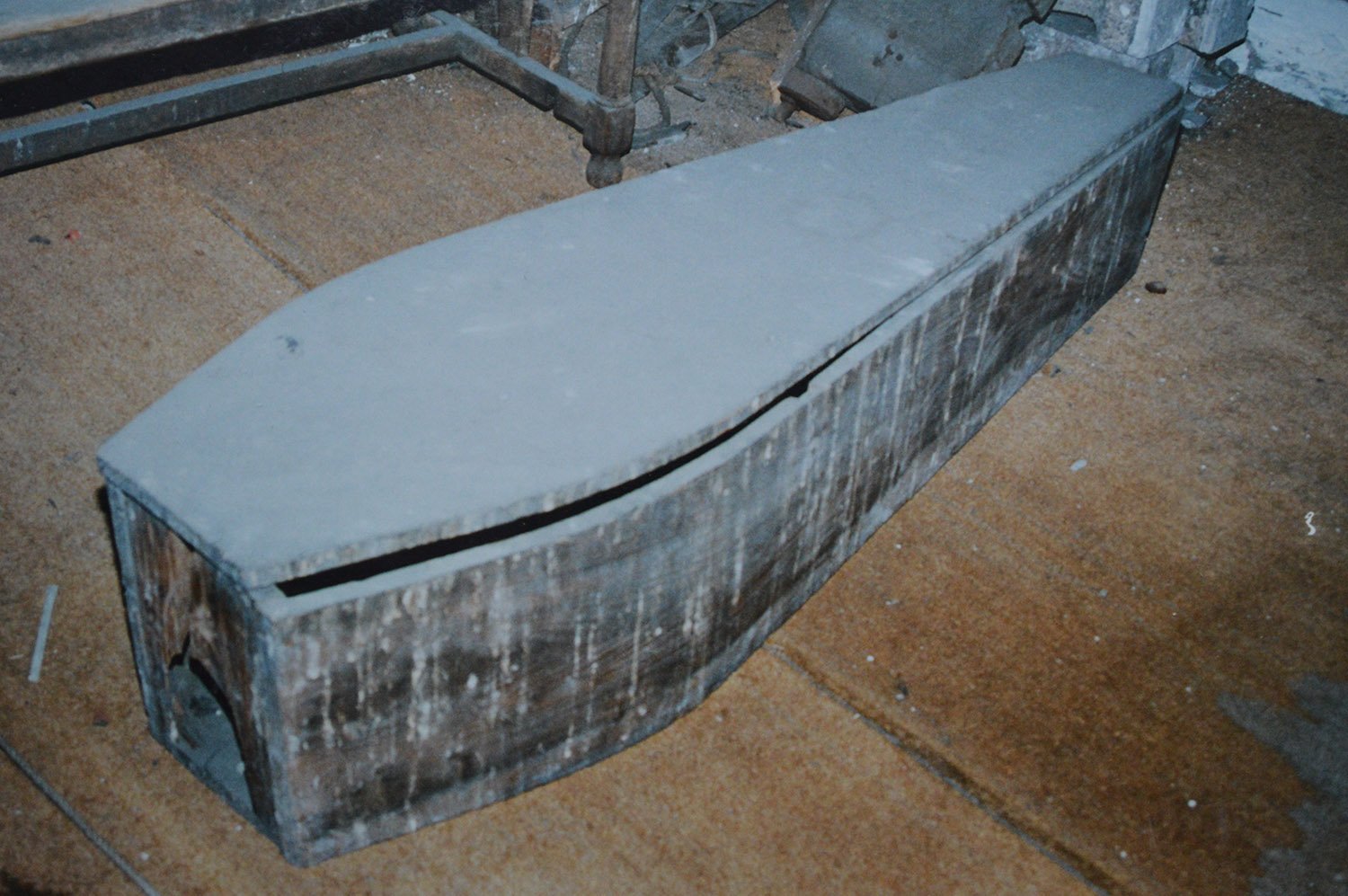
History of St James
St James has a rich and diverse history and tradition dating back to before the Norman conquest.

History of our Building
In the old days it was known as “Wren’s Lantern”, and although for a hundred years its east window has been entirely blocked up, and the lighting thereby reduced, it may still with complete justice claim that description
From Down Thames Street by Mark Rogers (1921)
One of the glories of The City of London is its skyline. Now punctuated by soaring office blocks in the east, in the west it is still the steeples of its Wren churches that define the horizon. St James is an honoured part of that rich landscape.
The exterior of the church is deceptively simple. The steeple, however, is one of the City’s most beautiful and ornate. Although not completed until 1714-17, the design for the tower and spire as they now are by Nicholas Hawksmoor survives in the British Library.
Inside, the gallery with its handsome double staircase, was added to accommodate the organ, which was installed in 1719 by Johann Knoppel.
The ceiling is the highest of any City church and Wren was so successful at introducing natural light into the church that it became known as Wren's Lantern.



In the early nineteenth century, the great east window was found to be causing a structural weakness and was replaced in 1815 with a painting of the Ascension by Andrew Geddes. This was given to the Church by the Revd Dr Thomas Burnet, then assistant curate, who was to spend his entire ministry in the Parish. The present frame is a gift of the Joiners and Ceilers Company.
St James is unusual among City Wren churches in having a structurally separate sanctuary. The chancel area was enlarged in 1876 to take the pulpit, with its preacher’s hat peg, and the choirstalls, which came from St Michael Queenhithe (now demolished). The backs of these stalls were fashioned from the doorframes of the old church. The finely carved and painted Stuart coat of arms on the south wall is also from St Michael's, while St James' Georgian arms are displayed on the north wall.
The original woodwork includes the altar table carved with doves, the font cover and the churchwardens' pews at the west end. These are all recorded as having been carved by one of Wren’s favourite woodcarvers, Willian Newman, who also carved our reredos, plus the fabulous pulpit and font cover at Stephen Walbrook. The font is of marble with carved cherubs' heads and was carved by Wren’s master stone mason, Christopher Kempster. Vestry records for 22 August 1682 record that he was given a free hand in carving the font so long as his cost did not exceed £20 (equivalent to £3,600 today).
The original ironwork includes the mayoral sword rest with lion and unicorn supporters on the south side. Those on the north side are from St Michael Queenhithe. The wrought iron on the churchwardens’ pews, depicts St James in pilgrims’ garb. This piece of ironwork was reproduced by the Victorians, to create their gas lamp standards on the choir pews.
The hatchments are also from St Michael Queenhithe - and commemorate King George III and Princess Charlotte Augusta, daughter of King George IV.
In the 2000s, a new parish room was built on the site of an old yard in the north-east corner of the church. During the construction, a family burial vault was discovered beneath the yard. The wisdom of the time was that it be filled with concrete, coffins et al. There is a memorial to the family, the Slaney’s, near the church entrance to the parish room.
There are other moving, and disturbing, monuments on the walls. One is to the Nesham family, which remembers the death of Sarah, aged 43 and goes on to record the deaths of fifteen of their children, most of whom did not reach their first birthday: a testament to the high child mortality rates of the times.
Another, a very fine tablet dating from 1675, commemorates Seagrave Chamberlain, who died at 16 years of age. This memorial is interesting since it must have been the first placed in the newly built church,
There are also wooden plaques on the south and north walls commemorating former Lord Mayors and other dignitaries who had monuments in the pre-Fire churches that make up the parish.




Of old time, on the banks of the River of Thames, near to this church, garlick was usually sold.
Stow’s Survey of London, 1598
Our History

Like so many of our City churches, the history of St James is one of survival through war, fire, drought, disease and misfortune.
It is thought a church has stood on Garlick Hill since Anglo-Saxon times. It is first mentioned as the 'Ecclesia Sancti Jacobi' in a will dated between 1096 and 1115. The first known Rector was Peter del Gannok in 1259. It was rebuilt in the fourteenth century by Richard de Rothing and his son John, both Vintners. The medieval church largely shared the footprint of the current building.
This existed alongside a religious guild for men and women which was founded on 25th July (St James’s Day) 1375. This was called the Guild (or Fraternity) of St James. Founded, according to their own account ‘for amendement of her Lyves, and of her Sowls, and to nourish more Love among the Bretheren and Sustrein of the Bretherhede’. It is interesting to note that “Sustrein” shows that both men and women were members of this Guild, for which we have their very detailed Points or Rules of the Fraternity. The Fraternity was closely concerned with the founding of the Joiners Company, though this link is sometimes overemphasised with some claiming that the Joiners started the Guild or that it grew out of the Guild, which is unlikely. It is far more probable that there were numerous members of the Craft of Joinery in the area who adopted the Guild and its Patron saint, and eventually formed themselves into the Worshipful Company of Joiners.
By the following century St James had become an important church with a number of chantries served by priests who were provided with quarters. This came to be known as St James Comyns, as it was recorded in 1481, the church serving a college of chantry priests, whose job it was to pray for the souls of the benefactors of their assigned chantries. It is apparent that, due to these chantries and other benefactions, the church became wealthy at this time, and some of its most prestigious burials occurred during this period. In 1381, besides the Rector, there were no fewer than 13 Chantry Priests, mostly endowed by John Rothing and Richard Lyons, placing St James within the top five City churches that had 11 or more chaplains.
Six Lord Mayors were buried in the medieval church, a sign of its importance. They are now commemorated by plaques on the north wall. In addition there were also the burials of a Mayor of Newcastle, Richard Lyons who was the Sheriff of London murdered by Wat Tyler, several other Aldermen and Sheriffs, and Sir Robert Chichele (brother of Henry, Archbishop of Canterbury and founder of All Souls College Oxford) who was probably the most influential Mayor of London after his contemporary and friend, Sir Richard Whittington. Inexplicably not recorded by plaques were several members of the nobility buried in our church mostly around the time of the Wars of the Roses, including several members of the noble Derby Family. These included George Stanley Lord Strange (who was held prisoner by Richard III in an unsuccessful attempt to retain the loyalty of his father, the Earl of Derby, at Bosworth Field), his mother, Lady Stanley, (who was Eleanor Neville, sister of Warwick the Kingmaker), John Stanley, George Stanley and a ‘Countess of Worcester and one of her children’, (probably Elizabeth Greyndour, wife of John Tiptoft, The butcher of England, 1st Lord Worcester).
There are two other enigmatic burials recorded, those of ‘Countess of Huntingdon’ and ‘Lady Herbert’, which some historians have supposed may have been one and the same person, making them probably Katherine Plantagenet, the ‘natural’ daughter of Richard III who held both titles.
An inventory of the Church’s goods, prepared by the Rector William Huntingdon in 1449 reveals a substantial collection of plate and vestments, as well as an impressive library of 41 manuscripts which included service books, bibles, music for singers (plainsong and choral) and, interestingly, four books of organ music. The library alone was valued at £154 and was second largest of those belonging to a City Parish at the time. The presence of an organ also points to the richness of the services that must have taken place in the medieval church.
After the Great Fire of 1666, Sir Christopher Wren rebuilt the Church at a cost of £5,357 .10s/ 10½d. The foundation stone was laid in 1676 and the re-opening took place on 10 December 1682, with the church being completed by the following year. Kipp’s famous London panorama of 1720 depicts the towers of St James, St Michael Paternoster Royal and St Stephen Walbrook without their steeples, although by then they had been added, that of St James being completed to Hawksmoor’s specifications by 1717.
In 1538, Henry VIII ordered churches to keep a register of births, deaths and marriages. Those at St James Garlickhythe are the oldest in England, the first entry being the Baptism of one Edward Butler on 18th November 1535 pre-dating the mandate by three years. William Boyce the composer was baptised here on 11th September 1711. The ancient registers and other City records are now stored at the London Metropolitan Archives.





Modern History
During the Great War, a bomb dropped by a Zeppelin narrowly missed the church, and for many years the Bomb service was held on the anniversary of the zeppelin bomb.
In World War II St James suffered less than many of the City churches.
During air raids volunteers would kick incendiary bombs off the roof, and put out small fires. Particular gallantry was shown by the local workers in the Fur Trade which was located around St James’s, particularly on the night of 11th January 1941, when the northwest corner of the roof caught fire from an incendiary. During this raid all the buildings opposite were destroyed as was the turret clock face on the tower, But a 500lb bomb did land on the church during the night of 10-11 May 1941, burying itself 30ft deep in the south-east corner, but not exploding. It remained there for a week until it could be removed to Hackney Marshes and exploded.
The Blitz also saw the end of the heavy Victorian stained glass. They were all blown out (which some might consider a blessing) though some shards can still be seen in the north and south rose windows. The tower clock, with its figure of St James, was also destroyed in a bombing raid on 11th January 1941. It was restored in 1988, largely through the generosity of the Vintners' Livery Company.
St James survived the war but very nearly didn’t survive the peace.
In 1954 minor repairs led to the discovery of death-watch beetle in the roof timbers, and the Church was closed until 1963. Its restoration was said by Sir John Betjeman to the finest of any of the Wren churches.
The latest bizarre episode in the survival story of St James happened in 1991.
A crane on Upper Thames Street, being used to build the new Vintners’ Place offices, toppled over and fell through the north wall. The roof and window were destroyed, the chandelier was smashed into smithereens, and the pews reduced to matchwood. This happened early in the morning when few people were about: Thankfully no one was killed, but the crane driver, Joe McGrath, suffered serious injury.
As one report from the time put it, St James ‘broke the crane’s fall’, causing an estimated £2m in damages.
The chandelier, given to the Church in 1967 by the Glass Sellers' Company, was restored from the original drawings and once again donated by the Glass Sellers' Company. The pews, originally in deal, were rebuilt in oak to match the choir stalls. The wood coming from trees felled during the ‘Great Storm’ of October 1987.
If you wish to know more about our history, please email our parish historian, Ellis Pike, via adminSJG@london.anglican.org.

Past Rectors
There have been a few notable incumbents in the parish.
In 1532 John Rogers received the living of Holy Trinity the Less, now the site of Mansion House tube station. Two years later he became chaplain to the English merchants in Antwerp, met William Tyndal, and was converted to the Protestant cause. He returned to London in the reign of Edward VI but was arrested during the reign of Queen Mary for preaching against the Pope. He was sentenced to death and burned at the stake at Smithfield on February 4th, 1555. A commemoration stone still exists at St Bartholomew’s hospital to remember the Protestant martyrs who died there.
Another reverend rebel was Robert Freeman. He became Rector in 1642, but in 1647, during the Commonwealth, he was ejected from the living for continuing to use the Book of Common Prayer. The parish continued to pay him a pension until his probable death in 1656. The Prayer Book was restored following the Restoration of the Monarchy in May 1660.
Philip Stubs was a Fellow of the Royal Society first Chaplain of Greenwich Hospital, and later Archdeacon of St Albans. He was active in Christian missionary societies, and social work, founding several day schools. Stubbs published numerous sermons most notably in 1702 ‘For God or for Baal.’ placing him firmly amongst the High Church clergy alongside the famous Dr Henry Sacheverell (with whom Stubs was depicted in one print). In 1713, the journalist Richard Steele visited St James and subsequently commended in the Spectator the manner in which Stubs took the service.
Maurice Foxell KCVO (Rector 1939-64) was simultaneously Rector of St James and Sub Dean of the Chapel Royal, eventually taking up residence at St James’s Palace. A notable print maker, he oversaw the post-war restoration of the church. Amongst other duties he assisted at the baptism of His Majesty the King. His diaries are preserved in the Imperial War Museum.

Jimmy Garlick
One of the most intriguing haunted churches in Britain can be found on Garlick Hill in the heart of old London.
Psychic News
The 1838 Vestry minutes state that extensive repairs were to be made to the church including instructions to the mason to “take up paving and steps to the altar and make level”.
It is probable that during these works the body of Jimmy Garlick was discovered, buried just below the floor of the chancel area, as the reports of his existence date from this period. He was then possibly taken down to the vaults, where he was re-discovered in 1855 when the vaults were cleared.
The mummified remains became known as Jimmy Garlick – and so the legend began.
The body should probably have been interred with all the other remains being removed from City churchyards to be reburied in City of London Cemetery, East London, but instead he remained at St James where he was put on display for visitors who would have to pay ‘a bob’ for the privilege of gazing at his remains. The probable culprits in this money raising scheme were Francis Caton the Parish Clerk, and Benjamin Hicks the Beadle (photo below). Initially Jimmy was kept behind the organ, but later he was moved, doubtless with the knowledge of Dr Burnet the Rector, to his cupboard in the narthex where he was more formally exhibited during arranged visitations. This must have been pre- 1890 when the book “The Bell of St Pauls” relates such a visitation. Indeed, a letter from Emma Garrod has been uncovered which talks of these visitations during her childhood, circa the late 1850’s. It is therefore probable that Jimmy was moved to his cupboard soon after having been retained by Caton and Hicks.
The stories of Jimmy’s ghost haunting the church in ghostly ire at being made a figure of public display are of 20th century origin.
According to Psychic News, “St James’s reputation as a haunted church began only after the discovery of the corpse, who was known as ‘Jimmy Garlick’. Visitors claimed to have felt a presence in the building and it was theorised that it was the ghost of the mummified man, unhappy as his less than dignifies treatment. It’s also said that choirboys sometimes carried the mummy around the church in jest in the 1930s - however the Rector, Fr ‘Johnny’ Johnson, soon put a stop to this.
There is also a story that during the Second World War, parishioners spotted a shrouded man walking through the church before air raids. A fireman certainly saw a pale-robed man during a bombing raid and shouted out to him, but he faded from sight before his eyes.
Others report a grey cowled figure, arms folded across the chest, gazing eastwards toward the altar.
Analysis by the conservation team at the British Museum in 1986 postulated that Jimmy was an adolescent who died at the turn of the 18th century. Subsequently this opinion was compounded by Julian Litten, Curator in Public Affairs for the V&A, an authority on historic burial techniques, who proclaimed that Jimmy was Seagrave Chamberlain, the 16 year old son of a Barbados sugar planter, whose memorial is on the wall in the north aisle.
In 2004, Jimmy featured in the Discovery Channel documentary series 'Mummy Autopsy', which used modern analytical techniques including carbon dating and x-ray analysis. This established that he probably died between 1652 and 1797. The strongest possibility, indicated by the highest carbon dating peak, being that he died around the time of the Great Fire of 1666. He also suffered from Osteoporosis, or brittle bone disease, which is common in older people.
Physical examination by the Discovery team showed that the mummy appeared to be balding and had lost some back teeth, but was not suffering from tooth decay at the time of his death. The lack of decay is interesting as this was a problem during his period associated with the upper classes in England who could afford the fad for sugar. However, this does not mean he was working class, he may have come from Europe where the diet of that time was generally better than in the UK.
Of course, theories abound about his identity, including that he was a sailor who died on board a ship docked close by and was buried in the church. However, this is most unlikely, as his bones suggest he led a fairly comfortable life, and certainly not one of manual labour. The fact that both his ears were pierced is interesting and may suggest a maritime background, or perhaps a continental upbringing. He had also been embalmed and in theory only important people would have been buried so close to the sanctuary, so he is unlikely to have been a mere ship’s hand.
The truth is we will never know the identity of Jimmy Garlick, and perhaps that is no bad thing.
Mention should also be made of the other ghost believed to haunt the church: that of a cat. Our proximity to St Michael Paternoster Royal, the church founded by Sir Richard Whittington four times Mayor of London and supposed keeper of cats (Dick Whittington of pantomime fame) has led some to wonder whether it might even be that cat! Whether it is or not the spectral St James cat has been spotted recently walking through the church.


